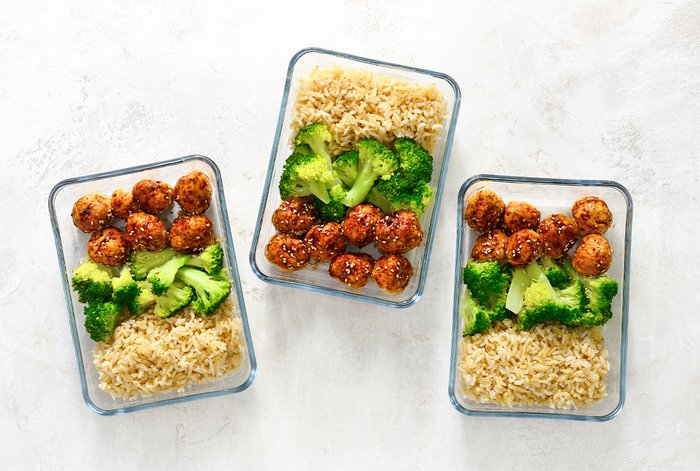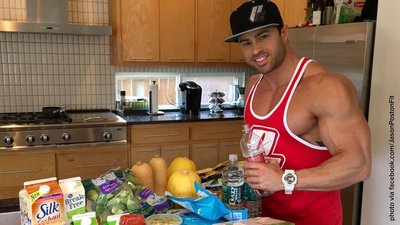Looking to pack on 10, 20, even 30 or more pounds of mass? Jason Poston, six months before his debut in the IFBB Classic Physique division, had some brutally simple advice.
"Just eat, dammit!" the ProSupps-sponsored athlete says with a grin.
Poston will be the first tell you there's much more to mass gains than simply gorging yourself on whatever food is within reach, but it's not a bad start.
"People get really stuck on specifics of weight gain," he says. "I look at the big picture, making sure I get six meals per day, eating every three hours. I don't get hung up on the exact timing or content of my meals."
To go from the more streamlined, fitness-model Physique division to Classic Physique and larger, more muscular competition, Poston aims to add around 40 pounds. Once he puts 240 pounds on his 5-foot-11 frame, this Dallas, Texas, athlete will chisel himself down to a rock-solid 210 onstage, a full 12 pounds heavier than he was for Physique shows.
Poston has Type 1 diabetes, an autoimmune disease that prevents his body from producing insulin, a crucial hormone. As a result, he has to go about mass gaining in a slightly different way, but the rules he lays out are designed to work for everyone. Here's how he's making it happen.
Fuel-Up Phase
Timing: 1-2 days before training
Foods: High protein, complex carbs, monounsaturated fats
Supplements: Whey protein isolate, branched-chain amino acids, meal-replacement bars
"I've always been very conscious of the fact that how I eat every day affects my performance," Poston says. "I eat and supplement with the intention of being one of the best in the world at what I do. The more consistent I can be with my nutrition program over the long haul, the better my results will be."
Poston's strategy is to increase his food intake a couple days before he trains bigger body parts.
"I eat more on the weekends," he says, "because I want to be fueled up when I train legs on Monday and back on Wednesday. I might taper down my carbs and my calories later in the week, but no matter what, I'm always eating, staying hydrated, and drinking branched-chain amino acids (BCAA) and creatine."
Pre-Workout Phase 1
Timing: 90 minutes before the workout
Foods: Beef, fish, chicken, or turkey breast; white, red, or sweet potatoes, rice
Supplements: None

Poston schedules his day so that he has three meals before his daily workout. It can get complicated, though, since he travels a lot for expo appearances and other events.
"I can't always perfectly time my meals or workouts, so I don't let those challenges derail me. I get the meals and the workouts in whenever I can," Poston says. "I'm a flexible dieter. I'll mainly eat clean, but every now and then I'll swap out foods just to keep my mind sane and cheat meals at a minimum."
Sometimes Poston will reach for Sour Patch Kids or Rice Krispies Treats instead of rice or potatoes. Being a Type 1 diabetic, he has to dose the same amount of insulin for 50 grams of candy as he does 50 grams of potatoes.
"You just can't do this kind of swap every day or you're not going to be elite," he says, "but I've found that I can do it maybe once or twice a week and still keep my preparation on track."
Pre-Workout Phase 2
Timing: 30 minutes before the workout
Food: None
Supplements: Pre-workout supplement including a nitric-oxide booster and creatine, along with caffeine, before back and legs trainin
"My muscles feel much fuller and more pumped when I take creatine and a nitric oxide booster in combination," Poston says. "I also recover faster when I take creatine before and after training."
"Since my heart rate increases naturally when I'm working the larger muscles, I use a stimulant-free pre-workout formula," he says. "When I'm training smaller body parts and don't get that natural boost, I may use a pre-workout with stimulants."
Poston says that when he trains people in the evening when they get off work, he usually recommends a higher-stim product so they have the energy to get to the gym and through the workout. He's found that people with naturally high energy need as little as 100 milligrams of caffeine to power them through a workout—if they need any stimulants at all.

Intra-workout Phase
Timing: During your session
Food: Water
Supplements: Carbohydrate drink (during longer training sessions) or a simple-sugar food
"I try to drink an enormous amount of water during every workout," Poston says. "I get dehydrated because my workouts are intense, the Texas heat makes me sweat like a pig, and my diabetes medication dries me out."
Poston's typical workout lasts about an hour. For back and legs, he's been known to go for as long as two hours.
"I do a lot of different exercises, eight hard sets each, to stimulate specific body parts. When I'm working out hard like that, I'll stop mid-workout and have a carb drink or some simple sugar."
When he does, he has to stop and give himself an insulin injection, since his body can't naturally produce that hormone anymore. But he says it's worth it to keep himself fully fueled for his workout.
Post-Workout Phase 1
Timing: Immediately after workout completion
Food: None
Supplements: BCAAs, creatine monohydrate, and simple-carb powders mixed with water
"After training, I need to replace lost nutrients and start the recovery process," Poston says. "When I'm walking out the gym door, I'm drinking BCAAs, creatine monohydrate, and a simple sugar powder mixed in water."
Poston notes that some people drink BCAAs during a workout. He might too, if it weren't for the fact that the leucine in BCAAs can cause blood sugar to increase for people with Type 1 diabetes. When people with normal glucose metabolism ingest leucine, BCAAs, or whey, their pancreas is stimulated to release insulin and lower their blood glucose levels. Poston doesn't have that luxury, so he avoids BCAAs until the workout is over. Otherwise, he might have to stop in the middle of the workout to inject himself with insulin.
Post-Workout Phase 2
Timing: 30 minutes after training
Food and Supplements: Whey isolate (40 grams) mixed with liquid egg white and almond milk
"By the time I get home, about 30 minutes has passed since my last set," Poston says. "That's when I drink a shake containing 40 grams of whey isolate."
Poston says you can mix your protein powder with water, but he likes to use almond milk because it's casein- and lactose-free. Coconut water could also be used to add some sugar, essential minerals and electrolytes, and taste to your post-workout shake.
"I'll also add liquid egg whites" he says. "A half cup of egg whites adds about 13 grams of high-quality complete protein to the shake."
Post-Workout Phase 3
Timing: 60-90 minutes after training
Food: Large meal that usually includes lean beef, and a selection of carbs such as white or red potatoes, sweet potatoes, sticky rice, quinoa, or whole-grain tortillas; sometimes a green veggie
Supplements: Digestive enzymes
About an hour and a half after working out, Poston sits down for a whole food meal that contains about 1,000 calories divided among protein, carbs, and fat.
High on his list of protein sources is beef. For carbs, he'll have a small serving: 50 grams of potatoes, 25 grams of rice, 25 grams of fruit, and maybe some quinoa or whole-grain tortillas or vegetables.
"I don't just have a pile of the same thing," he says. "My meals are more like buffets."
When Poston is traveling and crunched for time, he'll occasionally eat sooner than 60-90 minutes after his workout—even if he's still digesting his protein shake.
"I always take papaya-based digestive enzymes since I'm eating much more food than my body naturally needs," he says.

